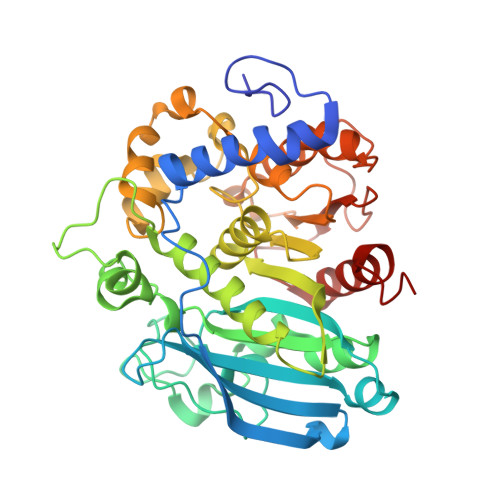Biochemical and structural features of diverse bacterial glucuronoyl esterases facilitating recalcitrant biomass conversion.
Arnling Baath, J., Mazurkewich, S., Knudsen, R.M., Poulsen, J.N., Olsson, L., Lo Leggio, L., Larsbrink, J.(2018) Biotechnol Biofuels 11: 213-213
- PubMed: 30083226
- DOI: https://doi.org/10.1186/s13068-018-1213-x
- Primary Citation of Related Structures:
6GRW, 6GRY, 6GS0, 6GU8 - PubMed Abstract:
Lignocellulose is highly recalcitrant to enzymatic deconstruction, where the recalcitrance primarily results from chemical linkages between lignin and carbohydrates. Glucuronoyl esterases (GEs) from carbohydrate esterase family 15 (CE15) have been suggested to play key roles in reducing lignocellulose recalcitrance by cleaving covalent ester bonds found between lignin and glucuronoxylan. However, only a limited number of GEs have been biochemically characterized and structurally determined to date, limiting our understanding of these enzymes and their potential exploration. Ten CE15 enzymes from three bacterial species, sharing as little as 20% sequence identity, were characterized on a range of model substrates; two protein structures were solved, and insights into their regulation and biological roles were gained through gene expression analysis and enzymatic assays on complex biomass. Several enzymes with higher catalytic efficiencies on a wider range of model substrates than previously characterized fungal GEs were identified. Similarities and differences regarding substrate specificity between the investigated GEs were observed and putatively linked to their positioning in the CE15 phylogenetic tree. The bacterial GEs were able to utilize substrates lacking 4-OH methyl substitutions, known to be important for fungal enzymes. In addition, certain bacterial GEs were able to efficiently cleave esters of galacturonate, a functionality not previously described within the family. The two solved structures revealed similar overall folds to known structures, but also indicated active site regions allowing for more promiscuous substrate specificities. The gene expression analysis demonstrated that bacterial GE-encoding genes were differentially expressed as response to different carbon sources. Further, improved enzymatic saccharification of milled corn cob by a commercial lignocellulolytic enzyme cocktail when supplemented with GEs showcased their synergistic potential with other enzyme types on native biomass. Bacterial GEs exhibit much larger diversity than fungal counterparts. In this study, we significantly expanded the existing knowledge on CE15 with the in-depth characterization of ten bacterial GEs broadly spanning the phylogenetic tree, and also presented two novel enzyme structures. Variations in transcriptional responses of CE15-encoding genes under different growth conditions suggest nonredundant functions for enzymes found in species with multiple CE15 genes and further illuminate the importance of GEs in native lignin-carbohydrate disassembly.
- 1Wallenberg Wood Science Center, Division of Industrial Biotechnology, Department of Biology and Biological Engineering, Chalmers University of Technology, Gothenburg, Sweden.
Organizational Affiliation:




















